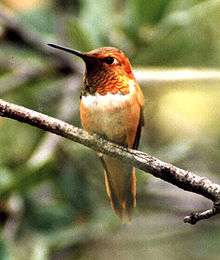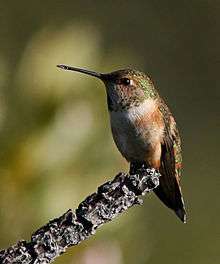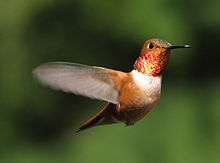Rufous hummingbird
| Rufous hummingbird | |
|---|---|
 | |
| Adult male | |
| Scientific classification | |
| Kingdom: | Animalia |
| Phylum: | Chordata |
| Class: | Aves |
| Order: | Apodiformes |
| Family: | Trochilidae |
| Genus: | Selasphorus |
| Species: | S. rufus |
| Binomial name | |
| Selasphorus rufus (Gmelin, 1788) | |
The rufous hummingbird (Selasphorus rufus) is a small hummingbird, about 8 cm (3.1 in) long with a long, straight and slender bill. These birds are known for their extraordinary flight skills, flying 2,000 mi (3,200 km) during their migratory transits. It is one of seven species in the genus Selasphorus.
Description

The adult male has a white breast, rufous face, flanks and tail and an iridescent orange-red throat patch or gorget. Some males have some green on back and/or crown. The female has green, white, some iridescent orange feathers in the center of the throat, and a dark tail with white tips and rufous base.
The female is slightly larger than the male. Females and the rare green-backed males are extremely difficult to differentiate from Allen's hummingbird. This is a typical-sized hummingbird, being a very small bird. It weighs 2–5 g (0.071–0.176 oz), measures 7–9 cm (2.8–3.5 in) long and spans 11 cm (4.3 in) across the wings.[2]
They feed on nectar from flowers using a long extendable tongue or catch insects on the wing. These birds require frequent feeding while active during the day and become torpid at night to conserve energy. Because of their small size, they are vulnerable to insect-eating birds and animals.
Breeding
Their primary breeding habitats are open areas, mountainsides and forest edges in western North America from southern Alaska through British Columbia and the Pacific Northwest to California,[2] nesting further north (Alaska) than any other hummingbird. The female builds a nest in a protected location in a shrub or conifer. Males are promiscuous, mating with several females.[2]
Migration

Western rufous hummingbirds migrate through the Rocky Mountains and nearby lowlands during May to September to take advantage of the wildflower season. They may stay in one local region for the entire summer, in which case the migrants, like breeding birds, often aggressively take over and defend feeding locations. Most winter in wooded areas in the Mexican state of Guerrero, traveling over 2,000 mi (3,200 km) by an overland route from its nearest summer home — a prodigious journey for a bird weighing only 3 to 4 g.
Most rufous hummingbirds that migrate to the southeast of the United States and Caribbean Islands are juvenile birds and adult females, with adult males seldom seen. Since juveniles or females are essentially indistinguishable from Allen's hummingbirds unless confirmed by close inspection, eastern rufous migrants may be classified as "rufous/Allen's hummingbirds".[2]
Hovering mechanics, metabolism, and sexual dimorphism

Digital imaging velocimetry was used to capture rufous hummingbird wing movements on film, enabling determination that the bird supports its body weight during hovering primarily by wing downstrokes (75% of lift) rather than by upstrokes (25% of lift).[3][4] When hovering during fasting, rufous hummingbirds oxidize fatty acids to support metabolism and food energy requirements, but can rapidly switch to carbohydrate metabolism (within 40 minutes) after feeding on flower nectar.[5]
Both male and female S. rufus are territorial; however, they defend different types of territories.[6] The more aggressive males fight to defend areas with dense flowers, pushing females into areas with more sparsely populated flowers.[6] Males generally have shorter wings than females, therefore their metabolic cost for hovering is higher. This allows males to beat their wings at high frequencies, giving them the ability to chase and attack other birds to defend their territory.[6] The metabolic cost of short wings is compensated for by the fact that these males do not need to waste energy foraging for food, because their defended territory provides plenty of sustenance.[7] Females on the other hand are not given access to the high concentration food sources, because the males fight them off.[6] Therefore, females generally defend larger territories, where flowers are more sparsely populated, forcing them to fly further between food sources.[6] The metabolic cost of flying further is compensated for with longer wings providing more efficient flight for females.[6] The differences in wing length for S. rufus demonstrate a distinct sexual dimorphism, allowing each sex to best exploit resources in an area.
Gallery
- Slow-motion video of rufous hummingbird attacking Anna's hummingbird at feeder. Video taken at 2000fps, or about 1/67th real-time.
- Rufous hummingbird feeding in slow motion at 2000fps or 1/67th real-time
References
- ↑ BirdLife International (2012). "Selasphorus rufus". IUCN Red List of Threatened Species. Version 2013.2. International Union for Conservation of Nature. Retrieved 26 November 2013.
- 1 2 3 4 "Rufous Hummingbird". All About Birds. Cornell Lab of Ornithology.
- ↑ "Master fliers of the bird kingdom". BBC. 27 June 2005. Retrieved 30 October 2009.
- ↑ Warrick DR, Tobalske BW, Powers DR (2005). "Aerodynamics of the hovering hummingbird". Nature. 435 (7045): 1094–7. PMID 15973407. doi:10.1038/nature03647.
- ↑ Welch KC Jr, Suarez RK (2007). "Oxidation rate and turnover of ingested sugar in hovering Anna's (Calypte anna) and rufous (Selasphorus rufus) hummingbirds". J Exp Biol. 210 (12): 2154–62. PMID 17562889. doi:10.1242/jeb.005363.
- 1 2 3 4 5 6 Kodricbrown; Brown. "Influence of economics, interspecific competition, and sexual dimorphism on territoriality of migrant Rufous hummingbirds". Ecology. 59. doi:10.2307/1936374.
- ↑ Feinsinger; Chaplin. "On the relationship between wing disc loading and foraging strategy in hummingbirds". The American Naturalist. 109. doi:10.1086/282988.
External links
| Wikimedia Commons has media related to Selasphorus rufus. |
| Wikispecies has information related to: Selasphorus rufus |
- Rufous hummingbird Species Account - Cornell Lab of Ornithology
- "Rufous hummingbird media". Internet Bird Collection.
- Rufous hummingbird photo gallery at VIREO (Drexel University)
- Interactive range map of Selasphorus rufus at IUCN Red List maps
